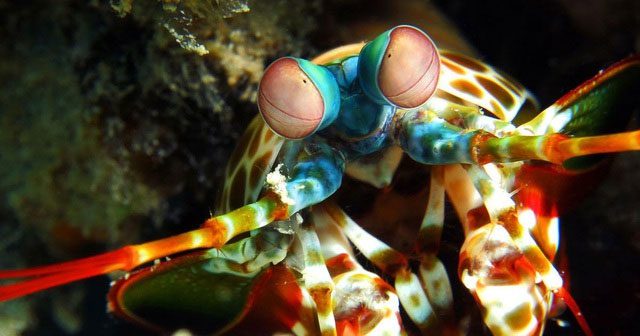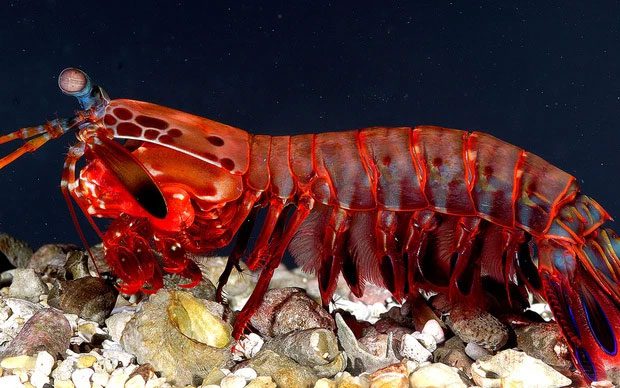With its hard, large claws and lightning-fast striking ability, the Mantis Shrimp is a formidable predator in the ocean.
Dubbed the “ocean killer,” the tiny Peacock Mantis Shrimp possesses a “weapon” capable of shattering its prey at speeds greater than 1,000 times its own weight.

The claws are the deadly weapon of the Mantis Shrimp. The shape of the claws resembles a mace.
Though referred to as a Mantis Shrimp, the Peacock Mantis Shrimp is neither a true shrimp nor related to mantises. Its appearance is a mix of both, which is why it is given this name. In reality, they belong to the class of crustaceans, distantly related to shrimp and lobsters.
The Mantis Shrimp (Stomatopoda) – also known as mantid shrimp, stomatopods, or prawn – is a group of crustaceans comprising over 400 species within the order Stomatopoda. They are often called mantis shrimp due to their shrimp-like appearance and mantis-like claws. They are distributed across temperate and tropical ocean regions worldwide. The body length of a Mantis Shrimp can reach up to 30 cm.
The claws are the deadly weapon of the Mantis Shrimp. Their shape resembles a mace. They attack prey by rapidly striking with their claws. When targeting crabs, snails, oysters, clams, and other hard-shelled prey, they use their claws to smash the shells. Prey can die instantly from the Mantis Shrimp’s assault, yet when fighting their kind, their strikes are non-lethal.
Mantis Shrimp strike with incredible speed (up to 23 m/s) and deliver forces of 1,500 Newtons with each punch. Scientists assert that when a Mantis Shrimp strikes, the acceleration of its claws is equivalent to that of a bullet.
Maya deVries, an associate professor of biological sciences at San Jose State University, explains: “Mantis Shrimp have a specialized energy storage system located where they flex their arms. They have a “lock” system to store energy there. This “lock” is muscle-controlled. So when the animal is ready to strike, it flexes its muscles to release the lock. When the lock is released, all the energy stored in the muscles and exoskeleton is released, and the claw, shaped like a hammer, lunges forward with incredible speed and acceleration.”

They attack prey by striking quickly and powerfully.
“Imagine punching a wall thousands of times at that speed without breaking your fist. That’s quite impressive. It makes us think about how Mantis Shrimp can do it,” says materials scientist David Kisailus from the University of California.
Upon closer examination, the research team discovered something astonishing: Mantis Shrimp have a special nano-coating that is impact-resistant and allows for energy absorption and dissipation.
Due to their rapid claw movements, Mantis Shrimp create tiny bubbles in the space between the claw and the target. When these bubbles burst, they generate significant force. This force enhances the striking power of the claws, greatly increasing their ability to kill prey. Even if the claw misses, the prey can still die from the force generated by the bubbles upon bursting.
Research shows that the spiral arrangement of α-chitin fibers combined with a fishbone structure can deflect and alter crack propagation.
The research team used Transmission Electron Microscopy – a tool for studying the microstructure of solids, utilizing a high-energy electron beam to pass through thin solid samples and employing magnetic lenses to create highly magnified images, and Atomic Force Microscopy to gain a close-up view of the Mantis Shrimp’s weapon. They also found that the coating is composed of a dense matrix of a mineral called hydroxyapatite, forming a nano-crystalline structure.
“At relatively low strain rates, the deformed particles behave like rubber and recover when the impact is reduced. While at high strains, the particles harden and fracture at the nano-crystalline surfaces, exposing new surfaces to dissipate a considerable amount of energy,” Kisailus explains.
This mechanism is genuinely impressive, surpassing many materials in hardness and elasticity. It could have remarkable applications in the future.

Mantis Shrimp strike with incredible speed (up to 23 m/s) and generate a force of 1,500 Newtons.
“It’s a rare combination that surpasses most metals and engineered ceramics. We can learn to create similar structures with advanced protective surfaces for use in automobiles, aircraft, or armor,” Kisailus emphasizes.
“The Destructive One” with Colorful Appearance
Boasting a vibrant array of colors from green, reddish-brown to pale yellow, the Mantis Shrimp’s appearance enhances its imposing presence as a predator in the deep sea. Fiercely attacking its prey, it is somewhat unfortunate that this “ocean killer” is… “colorblind.” Nevertheless, the keen eyes of this Peacock Mantis Shrimp have a unique and complex structure.
Its eyes contain light-sensing organs with up to 16 types of photoreceptors, allowing it to distinguish between coral reefs and even transparent species. Notably, this Mantis Shrimp can perceive polarized light, a rarity among other animal species. While its vision system is extraordinary and unusual, calling it colorblind is an exaggeration; it can distinguish many colors, but struggles with closely related hues, such as yellow and green-yellow.
Secretive, Solitary, and Uninterested in “Infidelity”
It is unclear how this dangerous predator plans its life, but they live very mysteriously and somewhat solitarily. The Peacock Mantis Shrimp spends most of its life in its burrow. Moreover, they also dislike “infidelity,” as many of them can pair with partners and bond for life. This lifespan may not exceed five years.
Regarding their survival tactics, the Peacock Mantis Shrimp can be seen as a ruthless hunting machine. They prefer to sneak and ambush. Notably, they are extremely determined and stubborn when hunting; if an attack fails, they will pursue their prey until they catch it.
Mantis Shrimp prefer to eat small mollusks and crustaceans. There are multiple reasons that make Mantis Shrimp the “warrior” of professional hunting in the ocean. They do not cherish unfamiliar catches; if it’s not to their liking, they drag it into their burrow and then disdainfully throw it out. Perhaps influenced by their reclusive lifestyle, they also enjoy eating scallops, clams, and snails, which are generally sluggish and not very mobile.

Mantis Shrimp prefer to eat small mollusks and crustaceans.
Mantis Shrimp often shed their claws several times a month, yet this does not hinder their ability to strike tens of thousands of times during that period. Scientists have uncovered a significant secret regarding the power of these Mantis Shrimp.
The surfaces of their claws are made of hydroxyapatite minerals that provide hardness and are arranged into columns perpendicular to the claw surface. The propulsion of these columns is aided by chitosan – a carbohydrate molecule formed from long chains of crustacean shell material. These are stacked at angles in multiple directions, which helps them avoid cracks when changing the direction of the claws.
Thanks to this remarkable capability, researchers intend to design hammers mimicking the claw mechanism of Mantis Shrimp for applications in aerospace, automotive, and more. With so many unique characteristics, they have won the hearts of marine life enthusiasts, even if they are… colorblind.


















































